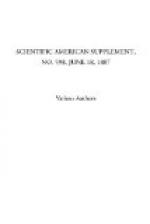But in ornamental art the case is entirely different. As it is to be applied and consequently subordinated to something, and does not exist for itself, it would be impossible, except in very rare instances, to introduce in a design a natural object in a realistic manner and not violate some important law of its growth or the conditions of its well-being. For instance, to exactly repeat a certain rose, with all the accidents of its growth, many times in a carpet is not natural. Nature never repeats herself. Moreover, to tread on that which is supposed to suggest to us real roses is barbarous. It would really be outraging and distorting nature while pretending to be her faithful disciple and imitator.
We not only derive from nature the most important materials for our designs, but also the various modes of arranging this material. Various modes of repetition—radical, bilateral, etc.—were all probably suggested by some natural arrangement observed in flowers, leaves, etc. Of these different arrangements it is curious to note that the bilateral is more characteristic of the higher forms of nature and the radiating of the lower. The leading principles of ornament—symmetry, proportion, rhythm, contrast, unity, variety, repose, etc.—are all exemplified in natural forms. The latter have also suggested many of the most important architectural forms. The Gothic cathedral, with its clustered columns branching and forming pointed arches overhead, was probably suggested by a grove of trees with overarching branches and boughs. The idea of the column was derived from the papyrus plant, a species of reed growing in the river Nile. The bud or flower suggested the capital of the column; the stalk, the shaft; and the bulbous root, the pedestal. The blue vault of the sky undoubtedly suggested the dome, etc.
The following are a few of the leading principles of ornamental art as set forth by Owen Jones in his Grammar of Ornament, a fine work, magnificently illustrated, whose perusal could hardly fail to delight the most indifferent:
“All good ornamental art should possess fitness, proportion, harmony, the result of all which is repose.”
“Construction should be decorated. Decoration should never be purposely constructed.”
“All ornament should be based upon geometrical construction.”
“Harmony of form consists in the proper balancing and contrast of the straight, the inclined, and the curved.”
“In surface decoration all lines should flow out of a parent stem. Every part, however distant, should be traced to its branch or root. Natural law.”
“All junctions of curved lines with each other, or with straight lines, should be tangential to each other. Natural law.”
“Natural forms, as subjects of ornament, should not be imitated, but should be conventionalized.”




